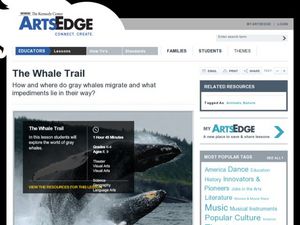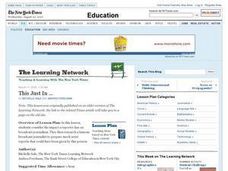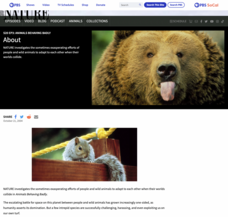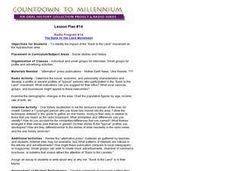American Press Institute
Media Literacy: Where News Comes From
What actually happens at a press conference? Make sense of the mayhem with a mock press conference activity designed to promote media literacy. Individuals participate as either members of the press or the governor's office to examine...
Newseum
Covering a Catastrophe: Press Conference Simulation
Young journalists have an opportunity to experience the challenges of covering a catastrophe by staging a mock press conference. Half the class acts as reporters while the others act as officials from the mayor's office.
Curated OER
Information Overload: Looking at News
How do events reported in mainstream newspapers, on television news, blog posts, and social network sites differ? Ask your class to investigate the way the same news item is presented in the many information sources available. Groups...
Curated OER
The Whale Trail
Students research the Gray Whale. In this Gray Whale lesson, students use KWL charts to organize information. Students do Internet research to gain information about the whales. Students get into groups and create a mock news broadcast...
Curated OER
A Newscast on Nigerian Women
Students research the history of Nigeria and the role that women have in its society. The students then showcase this information in a 10 to 15 minute newscast focused on the challenges faced by these women.
Curated OER
This Just In…
Students consider the impact a reporter has on broadcast journalism. They research a famous broadcast journalist to prepare a mock news report.
Carolina K-12
Political Parties and Conventions
The two major parties polarize many in America today, but it doesn't have to be that way in the classroom! Teach learners about political party platforms and modern campaigns with a mock political convention. After watching a PowerPoint...
Curated OER
News Anchor
Students view selected clips from news programs, analyzing the volume, stress and pacing of the deliverance. They prepare and deliver a one-minute presentation based on a current news story.
Curated OER
Cloud in the Classroom
Middle schoolers describe the relationship between animals and humans. In this biology lesson, students research about the history of horses in America. They present a mock news broadcast about their research.
Curated OER
Cloud in the Classroom
Students watch a video about wild stallions and conduct research about wild horses and wildlife photography. Students explore the relationships between animals and humans and conduct Internet research about the treatment of wild horses...
Curated OER
Sculptured Landscapes
Young scholars research glaciers, how they are formed and what kind of landforms they carve out of the rock they pass over. They organize their findings into a mock newscast in a presentation for the class.
Curated OER
Water: to the Last Drop
Middle schoolers research how water played an important role in US history. In this social studies lesson, students make a mock newscast from one of the events they researched. They present their newscast to the class.
Curated OER
Animals and People: Who's Behaving Badly?
Students explore the relationship between human beings and animals. They participate in a variety of activities to examine animal behavior. Students create a class book and stage a mock news broadcast.
Curated OER
Interview a Politician
Students, in groups of two, choose a politician of interest and research that person. They each assume the role of either the reporter or the politician and write a "mock" interview that they later present to the class.
Curated OER
Radio Program
High schoolers identify and assess the impact of unions on workers, management, and community. They listen to radio stories, students are asked what can they conclude about the impact of unions on the lives of the workers, management,...
Curated OER
Radio Program #14-The Back to the Land Movement
Students identify the impact of the "Back to the Land" movement on the Appalachian area. They interview people who have moved back or know someone who has moved back to the Appalachian area. Students graph out profiles of "typical"...

















